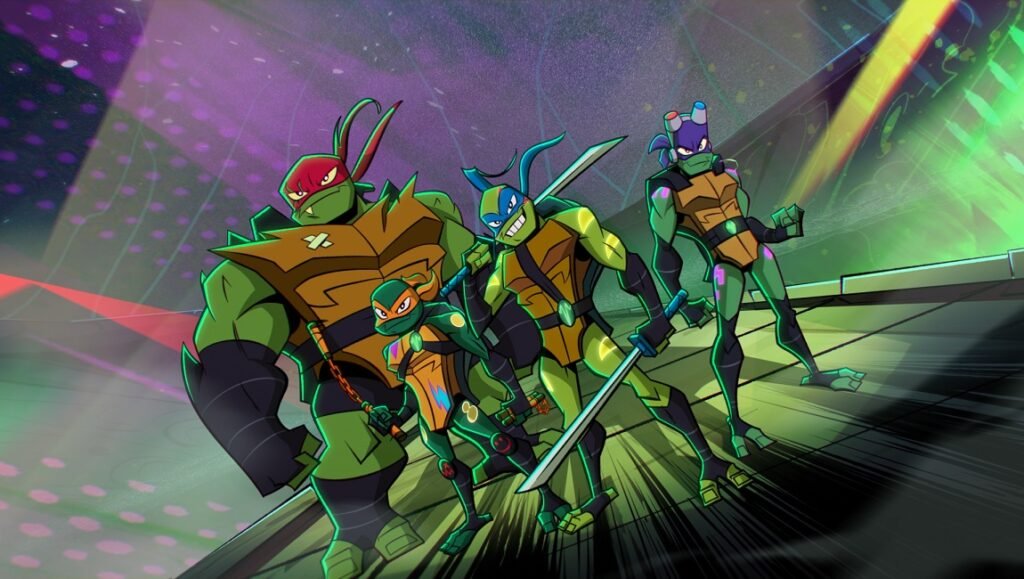This latest Ninja Turtles product is a narratively lazy and formally chaotic bit of empty IP.
As long as one doesn’t stubbornly insist on a puritanical approach to cultural phenomena, the evolution of such products is not only inevitable, but can offer welcoming reconfigurations. Of course, it isn’t always — or even necessarily often — the case that such repackaging heads in a wiser direction. Particularly when it comes to comic book stories and animated franchises, it’s easy to predict that such epochal changes will be hard(er)-pressed to please the old-school fandom. The beloved Teenage Mutant Ninja Turtles are no exception. Unlike David Wise & Patti Howeth’s amiable precedents (on syndication from 1987 until 1990, then moving to CBS until 1996) and their tougher, altogether more badass Lloyd Goldfine iterations (aired on FoxBox/4Kids from 2003 until 2009), the chelonian quartet of Leonardo, Raphael, Donatello, and Michelangelo recently adopted a far hipper look in their latest TV run on Nickelodeon (2018–2020), which the developing duo of Andy Suriano & Ant Ward have here rebooted into feature-length format for Netflix. Titled Rise of the Teenage Mutant Ninja Turtles: The Movie, this latest retooling is, at the very least, an opportunity to put Nickelodeon’s 3D, Playdoh-looking show (2012-2017) firmly behind them.
Given the many cosmetic changes the Turtles have undergone, the subterranean NYC warriors of this latest version aren’t likely to look too familiar to older generations of aficionados, notably shrunk in size, shape, and muscle mass here, as if lacking for pizza — except Raph, who’s rendered in gigantic proportions relative to the other three in order to double-down on his superior strength. Also present are a shorter, chubbier Master Splinter, adventurous news reporter/friend April O’Neil, who’s no longer a redhead but instead depicted as a young Black woman, and a meeker, though still hockey-loving, Casey Jones who now embodies more nice-guy qualities. In fact, the changes are so plentiful that it feels like only a minimum of the original defining TMNT traits are left — you barely even get to see the turtle crew use their specialized weapons. Oddly, in look and style it’s almost more accurate to comprehend of this animated movie as an upbeat riff on the underseen and nearly forgotten show Bucky O’Hare and the Toad Wars rather than the Ninja Turtles — if it weren’t for their distinctive colored bandanas, it would be difficult to view them as the same radioactively-augmented fellas. Still, the film’s most crucial problem isn’t found in its revised aesthetic — which admittedly leaves the impression of the particular lameness than comes from trying too hard to cool things up — but in its very lackluster, nearly one-note story.
Opening in a post-apocalyptic 2044 New York where wicked mastermind warlord Krang rules the world after stealing a secret key to a mysterious portal, the solution is obvious to Leo: send Casey back in time so that he can inform the Ninja Turtles about the catastrophic future and coax them on a mission to prevent Krang from ever getting hold of the key. Rise of the Teenage Mutant Ninja Turtles had every opportunity to gussy things up and bring a niftier style to the franchise — thanks to cutting-edge technology and improved FX and animation techniques — it seems it’s rather retreated into a much less imaginative comfort zone that demands very little both from its creators and the young audiences it’s made for. Absent an exciting story — how many times have we seen this trite time-travel narrative blandly played out? — and any true sense of strategy regarding spatial representations — almost all action occurs in the middle of void-like environments, with the foursome conducting their non-stop battle acrobatics against Krang from one chaotic frame to the next — the movie plays out mostly as an unhinged helter-skelter. Instead of an attentive concentration, Rise gradually numbs your senses with all its bombastic havoc to a point where it’s almost impossible to care who’s who or what’s really happening amidst its saturated, ultra-psychedelic color palette, irritating hyper-kineticism, and a handful of very indistinctive and unappealing villains.
If there’s a message to be found for the youngsters in the middle of this constant madcap — more ludicrous than joyous or entertaining — it’s something about regained brotherly love and familial fidelity, which is mostly realized as sentimental tweeness — particularly the plot point that has Leo going through a Disney-esque self-realization when faced with a haunted, zombie-looking Raph. But in fairness, despite of all the film undeniably lacks, the ultimately harmless Rise of Teenage Mutant Ninja Turtles is likely to please its young target audience. Essentially an extended 85-minute episode — which would be more precise and less exhausting in a traditional 20-minute format — adults shouldn’t spare more than a fleeting glimpse during the course of their Sunday morning routines. But even if kids are likely to find this latest TMNT effort diverting enough, they still deserve better stories and more imaginative entertainment than this hurried and noisy product, a film with the over-adrenalized temperament and empty spectacle of an amusement park.
You can currently stream Andy Suriano & Ant Ward’s Rise of the Teenage Mutant Ninja Turtles on Netflix.


Comments are closed.